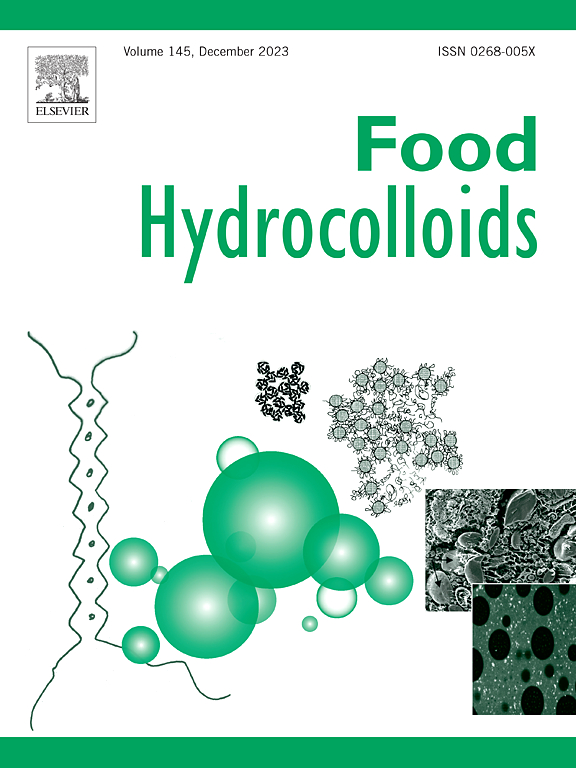Exploration of interaction mechanisms and functional properties of coffee flavonoids and β-casein via multispectroscopy and molecular dynamics simulation
IF 11
1区 农林科学
Q1 CHEMISTRY, APPLIED
引用次数: 0
Abstract
Milk coffee, a commonly consumed beverage, is prepared by mixing milk and coffee, which results in various interactions among their components. This study was aimed at investigating the interaction mechanisms of four coffee flavonoids (namely apigenin [AG], luteolin [LUT], quercetin [QC], and epigallocatechin gallate [EGCG]) and milk-derived β-casein (β-CN). Notably, LUT and QC bound to β-CN mostly via hydrogen bonds and van der Waals forces, whereas AG and EGCG primarily bound to β-CN via hydrophobic interactions. The trend of energy transfer efficiencies of the β-CN-flavonoid complex was as follows: β-CN-QC (50.20 %) > β-CN-LUT (43.68 %) > β-CN-EGCG (40.82 %) > β-CN-AG (35.34 %). Additionally, the dynamic behavior of the β-CN-flavonoid interaction and structural alterations in the protein were validated by molecular dynamics (MD) simulations. Multispectroscopy results revealed flavonoid-mediated alterations in the secondary structure of β-CN, including increased amounts of random coil structure and a decrease in the proportion of α-helix, which resulted in a more open and loose protein structure. The noncovalent interactions between flavonoids and β-CN lead to decreased protein surface hydrophobicity, increased solubility, improved emulsifying activity, albeit with decreased emulsifying stability, and improved foaming ability and foam stability. Furthermore, the complex exhibited a superior antioxidant activity to that of either protein or flavonoid alone, suggesting the synergistic action of the compounds on the antioxidant activity. Altogether, our results of this study offer a theoretical foundation for comprehending the interaction mechanisms among coffee polyphenols and milk proteins for the creation of a functional beverage such as milk coffee.

多光谱及分子动力学模拟研究咖啡黄酮类化合物与β-酪蛋白相互作用机理及功能特性
牛奶咖啡是一种常见的饮料,它将牛奶和咖啡混合在一起,导致它们之间的各种相互作用。本研究旨在探讨四种咖啡类黄酮(芹菜素[AG]、木犀草素[LUT]、槲皮素[QC]、表没食子儿茶素没食子酸酯[EGCG])与乳源性β-酪蛋白(β-CN)的相互作用机制。值得注意的是,LUT和QC主要通过氢键和范德华力与β-CN结合,而AG和EGCG主要通过疏水相互作用与β-CN结合。β- cn -类黄酮复合物的能量传递效率变化趋势如下:β-CN-QC (50.20%) >;β-CN-LUT (43.68%) >;β-CN-EGCG (40.82%) >;β-cn-ag(35.34%)。此外,通过分子动力学(MD)模拟验证了β- cn -类黄酮相互作用的动力学行为和蛋白质的结构改变。多光谱分析结果显示,黄酮类化合物介导的β-CN二级结构改变,包括随机螺旋结构的增加和α-螺旋比例的降低,导致蛋白质结构更加开放和松散。黄酮类化合物与β-CN之间的非共价相互作用导致蛋白质表面疏水性降低,溶解度增加,乳化活性提高,但乳化稳定性降低,发泡能力和泡沫稳定性提高。此外,该复合物的抗氧化活性优于单独的蛋白质或黄酮类化合物,表明化合物对抗氧化活性有协同作用。总之,我们的研究结果为理解咖啡多酚和牛奶蛋白之间的相互作用机制提供了理论基础,为创造一种功能性饮料如牛奶咖啡提供了基础。
本文章由计算机程序翻译,如有差异,请以英文原文为准。
求助全文
约1分钟内获得全文
求助全文
来源期刊

Food Hydrocolloids
工程技术-食品科技
CiteScore
19.90
自引率
14.00%
发文量
871
审稿时长
37 days
期刊介绍:
Food Hydrocolloids publishes original and innovative research focused on the characterization, functional properties, and applications of hydrocolloid materials used in food products. These hydrocolloids, defined as polysaccharides and proteins of commercial importance, are added to control aspects such as texture, stability, rheology, and sensory properties. The research's primary emphasis should be on the hydrocolloids themselves, with thorough descriptions of their source, nature, and physicochemical characteristics. Manuscripts are expected to clearly outline specific aims and objectives, include a fundamental discussion of research findings at the molecular level, and address the significance of the results. Studies on hydrocolloids in complex formulations should concentrate on their overall properties and mechanisms of action, while simple formulation development studies may not be considered for publication.
The main areas of interest are:
-Chemical and physicochemical characterisation
Thermal properties including glass transitions and conformational changes-
Rheological properties including viscosity, viscoelastic properties and gelation behaviour-
The influence on organoleptic properties-
Interfacial properties including stabilisation of dispersions, emulsions and foams-
Film forming properties with application to edible films and active packaging-
Encapsulation and controlled release of active compounds-
The influence on health including their role as dietary fibre-
Manipulation of hydrocolloid structure and functionality through chemical, biochemical and physical processes-
New hydrocolloids and hydrocolloid sources of commercial potential.
The Journal also publishes Review articles that provide an overview of the latest developments in topics of specific interest to researchers in this field of activity.
 求助内容:
求助内容: 应助结果提醒方式:
应助结果提醒方式:


